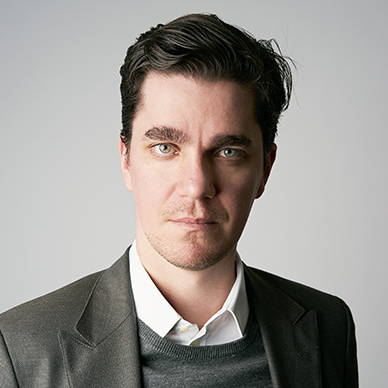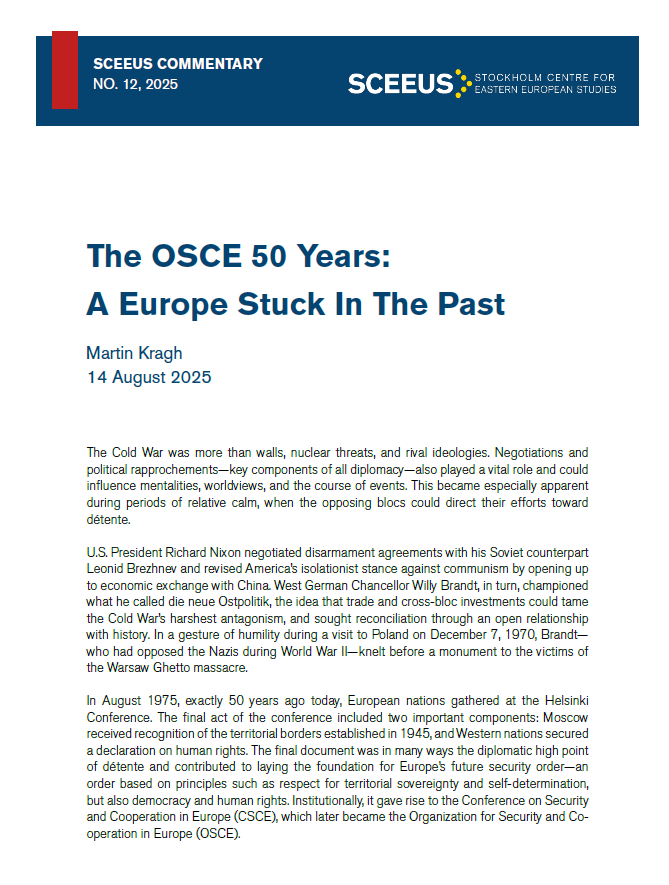SCEEUS Commentary No. 12
The Cold War was more than walls, nuclear threats, and rival ideologies. Negotiations and political rapprochements—key components of all diplomacy—also played a vital role and could influence mentalities, worldviews, and the course of events. This became especially apparent during periods of relative calm, when the opposing blocs could direct their efforts toward détente.
U.S. President Richard Nixon negotiated disarmament agreements with his Soviet counterpart Leonid Brezhnev and revised America’s isolationist stance against communism by opening up to economic exchange with China. West German Chancellor Willy Brandt, in turn, championed what he called die neue Ostpolitik, the idea that trade and cross-bloc investments could tame the Cold War’s harshest antagonism, and sought reconciliation through an open relationship with history. In a gesture of humility during a visit to Poland on December 7, 1970, Brandt—who had opposed the Nazis during World War II—knelt before a monument to the victims of the Warsaw Ghetto massacre.
In August 1975, exactly 50 years ago today, European nations gathered at the Helsinki Conference. The final act of the conference included two important components: Moscow received recognition of the territorial borders established in 1945, and Western nations secured a declaration on human rights. The final document was in many ways the diplomatic high point of détente and contributed to laying the foundation for Europe’s future security order—an order based on principles such as respect for territorial sovereignty and self-determination, but also democracy and human rights. Institutionally, it gave rise to the Conference on Security and Cooperation in Europe (CSCE), which later became the Organization for Security and Co-operation in Europe (OSCE).
However, the global situation remained fragile. In December 1979, Soviet forces invaded Afghanistan, beginning a decade-long conflict. Communist states never fulfilled their promises to respect human rights. And a (too) realistic NATO exercise in November 1983—Able Archer—was initially misinterpreted in Moscow as preparations for war, prompting the Soviet Air Force to load nuclear weapons onto its combat aircraft.
Yet on the other side of the Iron Curtain, the Helsinki Accords inspired the founding of several human rights organizations, such as Charter 77 in Czechoslovakia and Solidarność in Poland. In the spring of 1986, Mikhail Gorbachev introduced his policies of glasnost and perestroika—a promise of democracy and economic reforms. When hundreds of thousands of people in Estonia began a peaceful protest against Soviet occupation—a “singing revolution” that spread south to Latvia and Lithuania—the Soviet system began to wobble.
Soon, the Hungarian government dismantled the barbed wire fence on the border with Austria. Under mounting public pressure in East Germany—where hundreds of thousands of demonstrators had begun chanting “Wir sind das Volk” (“We are the people”)—the Berlin Wall was opened on November 9, 1989, allowing millions to cross into the Western neighbor. In December, the leader of the Czechoslovak Communist Party resigned and was replaced by the dissident and playwright Václav Havel.
Power dynamics—but also more fundamental ideas—were shifting. The clock was ticking for communism as a political system. Borders opened, censorship was lifted, archives were made public. Philosophers and dissidents spoke of responsibility, conscience, and truth, rejecting the language of power, lies, and cynicism. No one could fully grasp the potential of these changes—the forces that, between 1989 and 1991, would enable German reunification, a Soviet withdrawal from Afghanistan, the independence of Eastern European states, and the dissolution of the Soviet Union into 15 separate states.
On November 21, 1990, at the signing of the so-called Paris Charter—gathering all countries of the continent and the United States—a set of common principles was affirmed that only a few years earlier would have been dismissed as naïve ideals, if not fanciful illusions.
"The era of confrontation and division of Europe has ended,” declared the final document. “We declare that henceforth our relations will be founded on respect and co-operation. Europe is liberating itself from the legacy of the past.” It was a victory for diplomacy and a vindication for the Central and Eastern European countries that had been left to their fate at the Yalta Summit in 1945. For more than four decades, the continent had been artificially divided into two halves, with two opposing political and economic systems. Europe was no longer a continent in a state of permanent unrest. The Paris Charter pointed toward a future—a new era characterized by intergovernmental institution-building and continuous integration.
From today’s perspective, it is clear how uniquely favorable the international conditions were for this development. The United States enjoyed a dominant position in every respect and used it to promote democracy as a form of government globally. China still lacked the economic power that its Communist Party would later mobilize to expand its geopolitical influence. And Russia still had political leadership that, at least nominally, spoke the language of democracy.
The year 1999 was in many ways a decisive turning point—an annus horribilis for Europe’s fragile security climate. The United States, together with other NATO countries, attacked Serbia in support of Kosovo—without securing a mandate from the UN Security Council. Vladimir Putin, newly appointed as Russia’s Prime Minister, launched the Second Chechen War. And at the OSCE summit in Istanbul that November, Russia committed to ending its military occupation of the Georgian provinces Abkhazia and South Ossetia, as well as Moldova’s Transnistria—promises that remain unfulfilled to this day.
The Paris Charter had placed normative ideals such as democracy, rule of law, and human rights at the heart of international law—a moral universe that all signatory states were expected to adopt as their own. This was also a potential source of interstate friction. A country’s domestic political development could no longer be viewed in isolation but had immediate consequences for the rest of Europe. When hopes of continued integration were dashed and countries like Russia and Belarus embraced an authoritarian direction, the entire order was destabilized.
With its emphasis on consensus, the OSCE proved incapable of addressing Russia’s violations of the organization’s most fundamental principles and values. After the annexation of Crimea in 2014, the OSCE euphemistically referred to the “conflict in and around Ukraine,” without identifying Russia as the aggressor. European leaders primarily sought to freeze the conflict rather than address its root causes, insisting that the conflict had “no military solution”—an assessment unfortunately not shared by the Kremlin.
Politically, the OSCE was eroded on several fronts. Putin saw Western insistence on democracy and human rights as a cover for hard power interests—a way to undermine Russia’s sovereignty, and therefore something to be resisted both domestically and internationally. It was in this context that, for instance, OSCE monitoring missions were denied access to areas along the Russian-Ukrainian border, where Russian soldiers and weapons were believed to be flowing into Ukraine.
Contrary to OSCE principles, official Russian representatives began emphasizing the notion of “indivisible security”—the idea that no state can enhance its own security at the expense of others. From this perspective, Russian interventions in neighboring countries were not violations of international law but rather “legitimate defense measures”—against perceived threats from the EU and NATO, or simply to prevent developments deemed undesirable by the Kremlin. In practice, this principle has meant an insistence on a Russian sphere of interest—a veto over other countries’ political choices.
Institutions—the rules and norms created by people—do not exist in a vacuum. To function and possess legitimacy, they must also be respected and defended—something that, under current political conditions, has proven to be too much to ask. The OSCE, like other organizations born in the same era of optimism—such as the World Trade Organization (WTO) and the International Criminal Court (ICC)—has gradually been weakened over the years.
The hope for a Europe freed from “the legacy of the past” was premature. The continent witnessed the return of history. Fifty years after the signing of the Helsinki Accords, the OSCE remains a monument to a bygone era—a reminder of a time of stability in Europe that no longer exists. In this regard, Russia’s full-scale invasion of Ukraine on February 24, 2022, was not so much a turning point as the culmination of a longer phase during which international law had gradually eroded, and the foundations of the international order had been undermined.



The 28-point plan and its implications